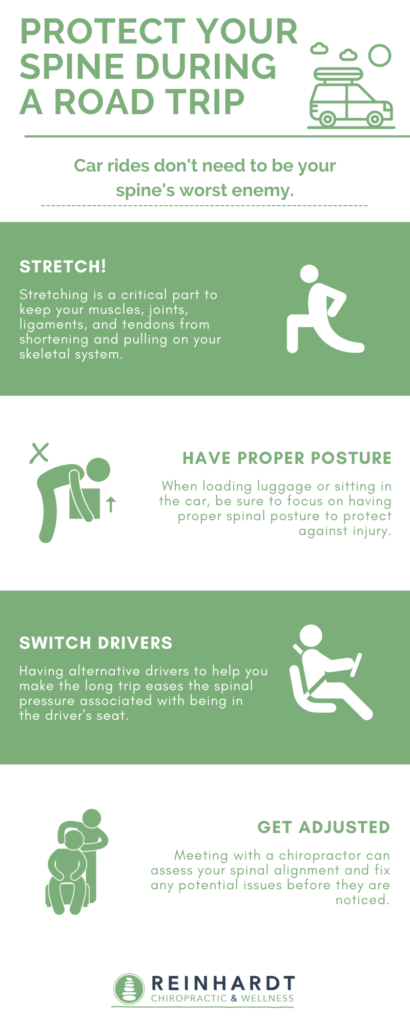Car rides can be a nightmare, especially for your spine. Sitting in a stiff, sedentary position for a long period of time can cause significant pain and displacement in your back. We’ve all been there, where we are several hours into a road trip and we feel our back start to tighten up — followed by all the aches. Our hips and legs start to cramp, our neck shoots with pains, and we can’t wait for the ride to end.
We exit the car and quickly start stretching and unwinding our bodies. The days that follow can be plagued with consistent spinal pain, contracted muscles, and poor circulation. However, you don’t need to experience these feelings once again.
There are several preventative measures you can take to before, during, and after your trip to ensure you keep your spine in the best possible shape.

Steps To Take Before The Road Trip
Avoiding back pain starts before even getting in the car. Spine injuries and back pain are often the results of improper care and preparation. It is important to get a good night’s rest the day before leaving. The best position to keep your spine neutral is by sleeping on your back or side. When you sleep on your back, place a pillow under your knees, along with a supportive neck pillow. If you are lying on your side, place a small pillow between your knees.
If you’re going on a road trip, you’re probably going to be packing luggage. Bad lifting technique is a major catalyst to back injuries. Proper spinal alignment, and not over lifting is essential to avoiding harm. Several tips to keep in mind include:
- Keep the object to be lifted close to your body
- Keep your back straight
- Head facing forward
- Tighten your stomach muscles
- Lift with your knees
- Ask for help with heavy items
The last thing to be aware of before hopping in the car is stretching. Our muscles tighten while we sleep (due to dehydration) and during prolonged sedentary positions (like sitting in the car). This causes tension and pulling on our skeletal system. In addition, it reduces optimal blood circulation. Prior to getting in the car, spend about 10 minutes stretching your legs, hips, back, and neck. This will help delay back pain and protect against spinal misplacement.
What To Do During The Road Trip
Now the hard part. Sitting. It is in this position that the most spinal discomfort occurs. With hours and hours ahead of you, muscles tighten up, shoulders round, joints stiffen, and more. During a road trip, drivers and passengers need to be conscious of their posture. Maintaining proper posture is critical to protecting your spine during a long car ride. Feet should sit squarely on the floor, your back and shoulders should be flush against the seat, and your head should be facing forward as much as possible.
Other tips include using a lumbar pillow to help relieve some pressure on your spine — don’t worry a rolled-up towel or T-shirt will get the job done. Another important decision to make is taking regular breaks. It can be tempting to push through a long drive, but pulling off at a rest stop to get out and stretch for 15 minutes will serve your back well in the days to come. Making a trip with a friend or family member is also a good idea. Not only does it give you social company, but alternating drivers helps eliminate some of the back strain that is only felt by the driver compared to the passenger. Finally, if you have a wallet or any other items in your back pockets, remove them before starting your journey.
Advice For After The Road Trip
Once getting to your destination, it is important to stretch once again. Loosen all your muscles, joints, ligaments, and tendons. Not allowing your body to mold to the shape of the car seat will help prevent pain and related issues in the coming hours and days.
Seeing a chiropractor after a long road trip is never a bad idea. Sometimes it can take weeks before symptoms and spinal alignment issues arise. A chiropractor will be able to assess your spine health and adjust any concerns or potential problems before they are noticed by an individual. The continued effort to best protect your spine is an investment in your long-term health.
Recent Post
Managing Stress and Tension: How Chiropractic Care Can Help
July 1, 2024
In our fast-paced world, stress and tension have become ever-present. Whether it’s the demands of work, family responsibilities, or the challenges of everyday life, many of us are constantly battling stress. At Reinhardt Chiropractic, we believe in a holistic approach to health that addresses not only physical pain but also the underlying stress that can
Read More…
Understanding the Benefits of Chiropractic Care for Athletes: Enhancing Performance and Preventing Injuries
June 1, 2024
In the world of sports, athletes are always seeking ways to improve their performance and prevent injuries. One often overlooked yet highly effective method is chiropractic care. At Reinhardt Chiropractic, we understand the unique demands placed on athletes and how chiropractic care can be a game-changer in their training and recovery regimes. Enhancing Performance Improved
Read More…

